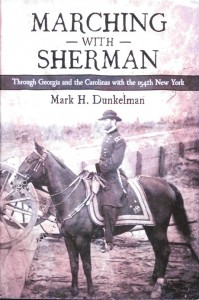Review by Larry S. Sterett | Contributing Editor
MARCHING WITH SHERMAN by Mark H. Dunkelman. ©2012. Published by the Louisiana State University Press, Dept. TGM, 338 Johnson Hall, Baton Rouge, LA 70803. Price: $39.95, plus shipping. Available at most bookstores.
 It has been 150 years since Sherman and his troops made their march to the sea through Georgia and the Carolinas. The story has been told many times in many ways by many people, but this latest account of the march is a bit different. This 292-page hardbound volume chronicles the participation of one regiment—the 154th New York—on that journey. It was a journey unlike any other.
It has been 150 years since Sherman and his troops made their march to the sea through Georgia and the Carolinas. The story has been told many times in many ways by many people, but this latest account of the march is a bit different. This 292-page hardbound volume chronicles the participation of one regiment—the 154th New York—on that journey. It was a journey unlike any other.
Following an interesting, longer than usual, Introduction, this tome is divided into 16 chapters, followed by acknowledgements, 40 pages of notes, an 18-page bibliography, and an index. In addition, to better aid the reader, there are five maps detailing the progress from Atlanta to Goldsboro, and a dozen illustrations, all period photographs or sketches.
More than a century after the fact, the author follows the route Sherman followed, as near as possible, from the start. By incorporating entries from wartime journals, interviews of descendants, and published accounts of the march, he has been able to present a more realistic view of the journey. Although African-Americans of the March era left few if any written records, their comments are still included. From 1936 to 1938, some twenty-three hundred ex-slaves were interviewed by employees of the Federal Writer’s Project of the Works Progress Administration (WPA). Recorded by the transcribers in the Uncle Remus style, the author has corrected the quoted dialects to increase clarity.
The final chapter—Don’t Bring Any Matches!—is particularly interesting, at least to this reader. It’s mention of “Sherman’s sentinels”—throughout the South any lone standing chimney is so called, no matter how far it may be from the actual line of March, or whether Sherman’s troops were ever in the area, is just one of the legends. Sherman was blamed for almost any injustice, even if he had not passed within miles of the area involved. Other legends revolve around masonic ties as the reason a house or plantation was spared, or Sherman was drinking with the mayor, or the town’s women cooked a fried chicken dinner for the general and his men, or some such other reason. Very interestin’.
This book is worth reading, especially if you are a Civil War history fan, for the simple reason it attempts to tell the story of one of the most famous marches in history from both sides of the fence. The story will never be complete, but Mark Dunkelman has come close with his coverage of the journey of the 154th New York through the three states of Georgia, South and North Carolina.




